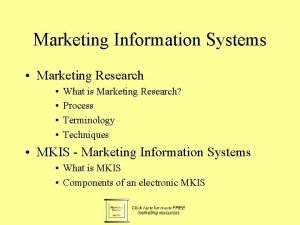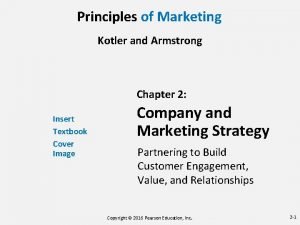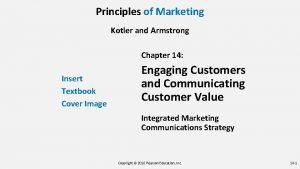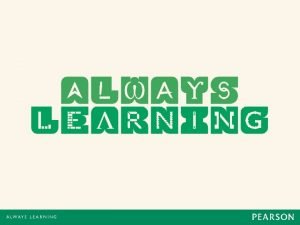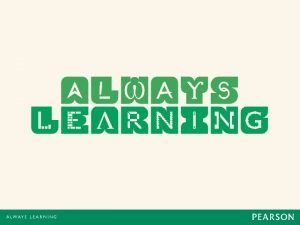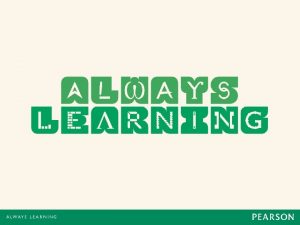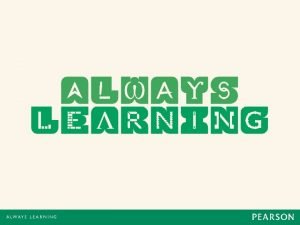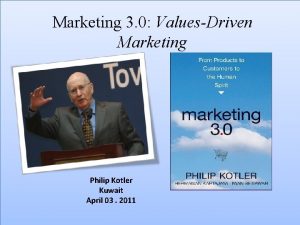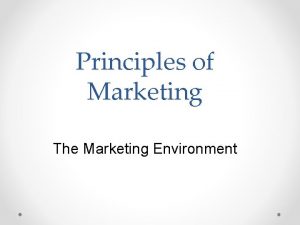Marketing Intelligence systems and Marketing Research Kotler on





















- Slides: 21

Marketing Intelligence systems and Marketing Research .

Kotler on Marketing is becoming a battle based more on information than on sales power. 5 -2

INFORMATION I don’t know if we should enter the Indian Market. REDUCES UNCERTAINTY .

Marketing Information and Customer Insights • Companies are forming customer insights teams – Include all company functional areas – Use insights to create more value for their customers. e. g. Kraft Foods – Director of consumer Insights Unilver’s customer Insight Group states in Misson : getting better at understanding our customer and meeting their needs” Wal-Mart's Retailink system gives key suppliers access to information on customer buying patterns and inventory levels Dell creates premium pages for large customers – access to product design , order status , and product support and service information

Developing Marketing Information Marketers obtain information from Internal data Marketing intelligence Marketing research

Developing Marketing Information Internal Data Internal databases are electronic collections of consumer and market information obtained from data sources within the company network Pizza Hut database contains 40 million US Households from Phone orders , POS Transactions at its more than 7, 500 restaurants around the Nation , VIP(very into pizza) program to retail customers

Developing Marketing Information Marketing Intelligence Marketing intelligence is the systematic collection and analysis of publicly available information about consumers, competitors, and developments in the marketplace Eves dropping on market place and snooping on competitors , Monitoring internet buzz or observing consumers first hand to quizzing the company’s own employees, benchmarking competitors products , researching the internet , Lurking around industry trade shows and even noting through rivals trash bins , Nielson reports P&G admitted to Dumpster Diving at rival Unilever’s Helene Curtis headquarters in the United Nations.

Marketing Research Defined Marketing research is defined as: the systematic and objective process of generating information for aid in making marketing decisions. Marketing research is one of the principal tools for answering questions because it: • Links the consumer, customer, and public to the market through information used to identify and define marketing • Generates, refines, and evaluates marketing actions • Monitors marketing performance • Underlines the understanding of marketing as a process

Developing Marketing Information Steps in the Marketing Research Process Copyright © 2010 Pearson Education, Inc. Publishing as Prentice Hall Chapter 4 - slide 9

Marketing Research System • The Marketing Research Process – Step 1: Define the Problem, the Decision Alternatives, and the Research Objectives – Researchers must work closely together to define the problem and agree on research objectives – Researcher might have one of three objectives

Research Objectives : Exploratory Research • When there is little information about the phenomenon to be investigated. • It begins with review of secondary data – Interview knowledgeable people , Focus group e. g. Soft Drink manufacturer’s faced with decreased sales might conduct an exploratory study to generate possible explanations Launch a new product and assess consumer reactions Copyright © 2000 by Harcourt, Inc. All rights reserved.

Research Objectives : Descriptive • Determining the frequency with which something occurs or the relationship between the two variables e. g. Trends in the consumption of soft drink with respect to characteristics such as Gender , age and geographic location

Research Objectives : Causal research • To test hypothesis about cause and effect relationship e. g. Would 10% decrease in fee would result increase in enrolment of students in the MBA Institute Statement of the problem and objectives guide the entire research process The manager and researcher should put the statement in writing to be certain that they agree on purpose and expected results of the research

Marketing Research System – Step 2: Develop the Research Plan • Data Sources: Secondary & primary sources • Research Approaches – Observational research: Fisher price play labs , Huggies wipe package with push button one handed dispenser – Ethnographic research: Nokia deploys teams of anthropologists – Survey research : Flexible – Experimental research – Mc Donald researching its sandwich in two similar cities and then differences in sales in the two cities could be related to the price change

Marketing Research System • Contact Methods – Mail questionnaire – Telephone interview – Personal interviewing • Individual interviews • Group interviews : Focus Groups • Online methods: Internet surveys , online panels , online focus groups, virtual interview rooms

Figure : Focus group research

Marketing Research System • Sampling Plan: Segment of population selected for Marketing research to represent the population as a whole – Sampling unit – who is to be surveyed? – Sample size- how many people should be surveyed? – Sampling procedure- How should respondents be chosen?

Probability and Nonprobability Samples A. Probability Sample Simple random sample Every member of the population has an equal chance of selection Stratified random sample The population is divided into mutually exclusive groups (such as age groups), and random samples are drawn from each group Cluster (area) sample The population is divided into mutually exclusive groups (such as city blocks), and the researcher draws a sample of the groups to interview

Probability and Nonprobability Samples (Continued) B. Nonprobability Sample Convenience sample The researcher selects the most accessible population members Judgment sample The researcher selects population members who are good prospects for accurate information Quota sample The researcher finds and interviews a prescribed number of people in each of several categories

Marketing Research System • Research Instruments in collecting primary data – Questionnaires – Psychological tools – in-depth interviews – Mechanical devices – Galvanometer , audiometer – Qualitative measures – video , informal interviewing

Marketing Research System • Implement the Research Plan: Collecting , processing , and analyzing the information • Interpreting and Reporting the Findings : draw conclusions and report them to management
 Marketing research process kotler
Marketing research process kotler 3 types of marketing research
3 types of marketing research Marketing research process kotler
Marketing research process kotler Marketing information systems and marketing research
Marketing information systems and marketing research Marketing information systems and marketing research
Marketing information systems and marketing research Marketing information systems and marketing research
Marketing information systems and marketing research Marketing information systems and marketing research
Marketing information systems and marketing research Marketing information systems and marketing research
Marketing information systems and marketing research Marketing information systems and marketing research
Marketing information systems and marketing research New consumer capabilities in marketing
New consumer capabilities in marketing Company and marketing strategy chapter 2
Company and marketing strategy chapter 2 Kotler and armstrong principles of marketing
Kotler and armstrong principles of marketing Kotler et al 2017
Kotler et al 2017 14 principles of marketing
14 principles of marketing Principles of marketing by philip kotler
Principles of marketing by philip kotler Capturing marketing insights
Capturing marketing insights Benefits of secondary research
Benefits of secondary research Marketing management (arab world edition) philip kotler
Marketing management (arab world edition) philip kotler Marketing management (arab world edition) philip kotler
Marketing management (arab world edition) philip kotler Marketing management (arab world edition) philip kotler
Marketing management (arab world edition) philip kotler Marketing management (arab world edition)
Marketing management (arab world edition) Define marketing information management
Define marketing information management




